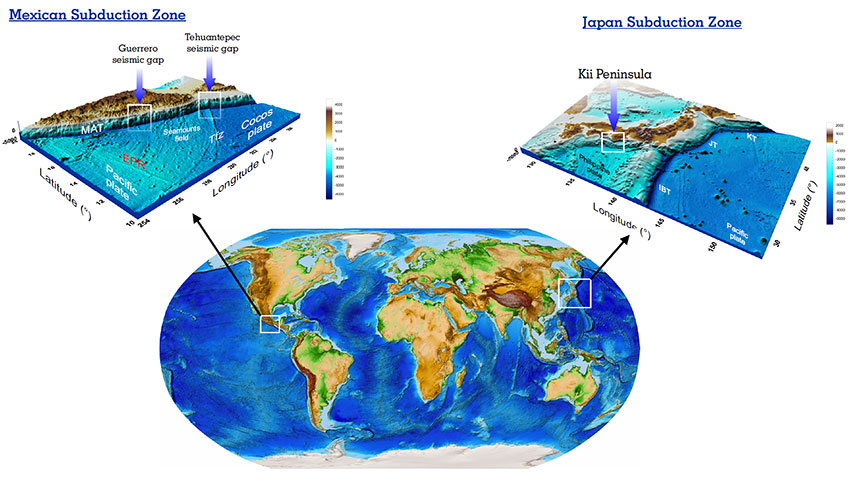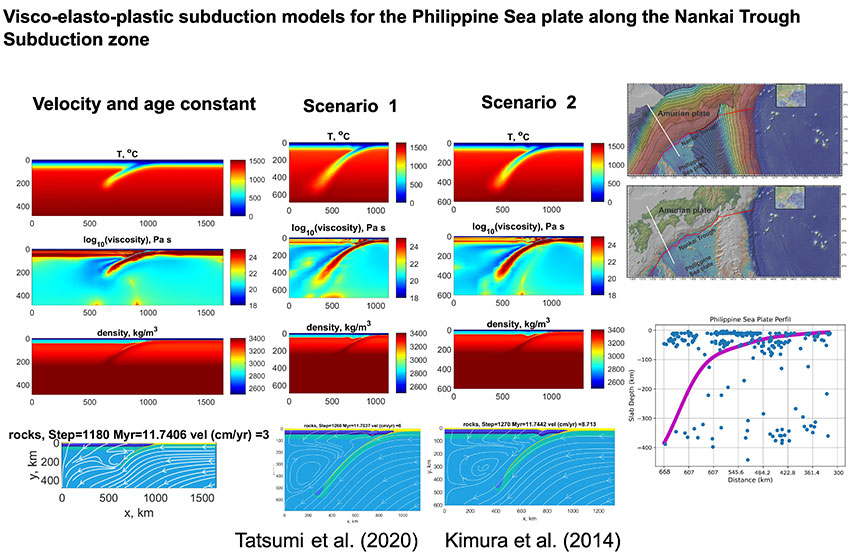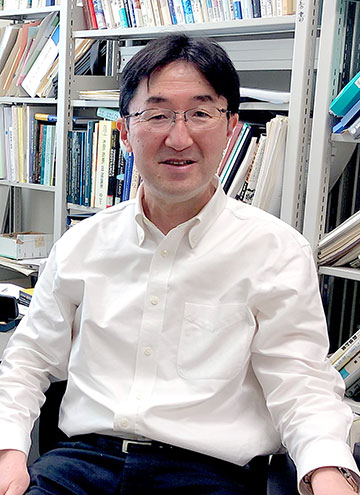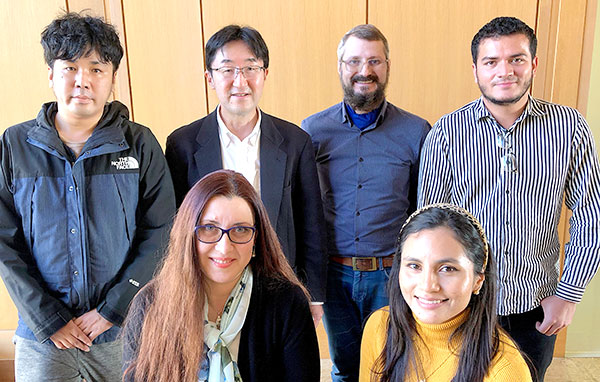Project Description
The Pacific Rim subduction zones are where oceanic plates subduct beneath continental plates. These zones are also where the most devastating earthquakes occur, inflicting enormous human, physical and economic damage. The subduction zones located in Japan, Mexico and Chile in particular have experienced increased seismic activity, resulting in very strong and destructive earthquakes impacting these three countries in recent years.
In addition, each of these countries have so-called seismic gaps, such as the Nankai Trough in Japan, Guerrero in Mexico, and Atacama and Valparaiso in Chile. The likelihood of huge earthquakes occurring in these areas in the near future has been pointed out. Furthermore, research advancements in recent years have led to the discovery of slow earthquakes. Slow earthquakes have occurred at plate boundaries along shallow and deep extensions in the previously mentioned seismic gaps, thus many researchers have focused on the relationship between slow earthquakes and great earthquakes.
Therefore, understanding the mechanism behind how great earthquakes are generated in these three countries is essential for disaster mitigation and building hazard assessments. To this end, it is critical to understand plate subduction dynamics in these regions, as well as to obtain better insight into the underlying physical processes and interactions that contribute to the occurrence of great earthquakes. In order to illuminate these aspects, an international joint research project entitled ‘Elucidation of generation mechanism of great earthquakes in Japan, Mexico, and Chile’ was started in 2022. This is three-year project that has been awarded the Kobe University Strategic International Collaborative Research Grant (Type B: Fostering Joint Research). Through international joint research on the generation mechanism of great earthquakes in the subduction zones of Japan, Mexico, and Chile, the project aims to deepen our understanding; clarifying the universal and regional aspects behind how such earthquakes occur.


Comments from the Project Leader
Professor YOSHIOKA Shoichi (Professor of the Research Center for Urban Safety and Security /Graduate School of Science)

In this project, researchers from Japan, Mexico, and Chile work together with the aim of clarifying the generation mechanism of great earthquakes. Our research is based on the latest data and knowledge, and we apply numerical simulations and data analysis methods. It is not easy to tackle this challenging issue, but we believe that we can produce significant research results in the fields of science and disaster prevention. Your interest in and opinions on our outcomes are greatly welcome. In addition to these three countries, many others have also experienced great earthquakes. We hope that our results will spread to researchers in such countries, as well as researchers who are interested in elucidating the generation mechanism behind great earthquakes, expanding the scope of collaborative research on this topic.
International Collaboration
Through the project, we are conducting joint research with researchers mainly at the National Autonomous University of Mexico and the University of Chile. We have two major research units:
1. Joint research with the National Autonomous University of Mexico
Three researchers from the National Autonomous University of Mexico have been invited to Kobe University from the end of June 2022. They will stay here for a period of over one year to conduct research on 1) Estimation of the deformation, temperature structure, and dehydration distribution at the plate boundary associated with seamount subduction, 2) Construction of a two-dimensional visco-elasto-plastic plate subduction model in the Nankai Trough off southwest Japan, and 3)The relationship between three-dimensional temperature and dehydration distributions and interplate seismic events associated with the subduction of the Cocos plate in Mexico.
2. Joint research with the University of Chile
Working with researchers at the University of Chile, we are conducting research on 4) Estimation of the slip distribution of the 2015 magnitude 8.3 Illapel earthquake in Chile by joint inversion using GNSS and tsunami data, and 5) Relationship between three-dimensional temperature and dehydration distributions associated with subduction and interplate seismic events.
In January 2023, we are planning to invite researchers from the University of Chile and the University of Concepción for a short period of time. Through deep learning using Japanese GNSS data, we will divide the Japanese archipelago into several crustal blocks and attempt to estimate the interactions between the blocks using inversion.
When the project is completed in 2024, we will summarize and integrate each of the above studies and publish them as internationally co-authored papers. We will also look at how each piece of research can be improved upon.
The project members meeting at Kobe University

(Back row from left)
- - SUENAGA Nobuaki (Academic Researcher, the Research Center for Urban Safety and Security Kobe University)
- - YOSHIOKA Shoichi (Project Leader)
- - Vlad Constantin MANEA (Senior Researcher, National Autonomous University of Mexico)
- - Andres David BAYONA Ordonez (PhD student, National Autonomous University of Mexico)
(Front row from left)
- -Marina MANEA (Senior Researcher, National Autonomous University of Mexico)
- -Erika Jessenia MORENO (Research Associate, the Research Center for Urban Safety and Security, Kobe University)
Information on related research facilities




